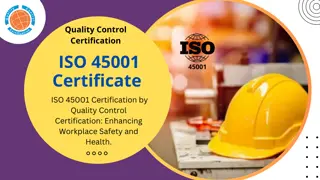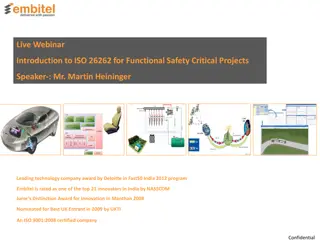Comparison of Weathering Test Specifications in ECE Regulations and ISO Standards
The weathering test specifications in ECE Regulations 69, 70, and 104 are compared to ISO Standard ISO 105-B02:1978 and EN ISO 4892-2:2013 (amended in 2021). ISO 105-B02 focuses on determining the effect of artificial light on textile colors, while ISO 4892-2 defines clear apparatus conditions for weathering tests. The latter method simplifies understanding and avoids unnecessary requirements, making it more effective for testing materials under simulated weathering conditions.
Download Presentation

Please find below an Image/Link to download the presentation.
The content on the website is provided AS IS for your information and personal use only. It may not be sold, licensed, or shared on other websites without obtaining consent from the author.If you encounter any issues during the download, it is possible that the publisher has removed the file from their server.
You are allowed to download the files provided on this website for personal or commercial use, subject to the condition that they are used lawfully. All files are the property of their respective owners.
The content on the website is provided AS IS for your information and personal use only. It may not be sold, licensed, or shared on other websites without obtaining consent from the author.
E N D
Presentation Transcript
SLR-58-03 Outcome of SLR-57 R48 The latest version is available in doc. SLR-58-02. However, the file with all comments in track-change resulting from SLR-57 (plus draft additional justifications from OICA) is available - for information purposes - as SLR-57-02/Rev.1. R86 The latest version is available in doc. SLR-57-08/Rev.1. The HWT-R86 shall add the justification and submit a revised proposal to SLR-58 for final check. To keep the reference to R 104 in R 48 and amend to reed: compliant with UN Regulation No. 104 or the 00 or subsequent series of amendments to or R 150 compliant with UN Regulation No. 70 or the 00 or subsequent series of amendments to or R 150 compliant with UN Regulation No. 3 or the 00 or subsequent series of amendments to or R 150 To keep the reference to R 104, R 70, R 69 in R 86 and amend to reed: compliant with UN Regulation No. 104 or the 00 or subsequent series of amendments to or R 150 compliant with UN Regulation No. 70 or the 00 or subsequent series of amendments to or R 150 compliant with UN Regulation No. 69 or the 00 or subsequent series of amendments to or R 150
The specification of the weathering test in ECE Regs 69, 70 and 104 in comparison to R150-01 ISO Standard ISO 105 - B02 1978 vs EN ISO 4892-2:2013 (amended in 2021) Textiles Tests for colour fastness Part B02: Colour fastness to artificial light: Xenon arc fading lamp test (ISO 105-B02:2014); This part of ISO 105 specifies a method intended for determining the effect on the colour of textiles of all kinds and in all forms to the action of an artificial light source representative of natural daylight (D65). The method is also applicable to white (bleached or optically brightened) textiles. The methode described in ISO 105-B02 is very complicated and is based on visual control and references The definitions of the weathering contition for the aperatus are not clear defined - already a 25 year old standard. In ISO 4892-2 the conditions for aperatus for weathering are clearly defined. The weathering is done by a fixed definition of the time and cycle of exposure. ISO 4892-2 Methods of exposure to laboratory light sources Part 2: Xenon-arc lamps This part of ISO 4892 specifies the methods of exposing test specimens to xenon arc radiation and humidity in an apparatus to simulate the effects of weathering (temperature, humidity and/or wetting) that occur when materials are in real end-use conditions Environments exposed to global radiation or global radiation behind window glass. The methode according ISO 4892-2 is better to understand and will not raise the requirement
UN Regulation 104 Annex 8 RESISTANCE TO EXTERNAL AGENTS 1. Resistance to weathering 1.1. paragraph 2.1.4. of this Regulation) are taken. One specimen shall be stored in a dark and dry container for subsequent use as "reference unexposed specimen". Procedure - For each test, two specimens of a sample unit (see The second specimen shall be subjected to a source of illumination in accordance with ISO Standard 105 - B02 - 1978, Section 4.3.1; the retro- reflective material shall be exposed until blue standard No. 7 has faded to No. 4 on the grey scale. After the test, the specimen shall be washed in a dilute neutral detergent solution, dried and examined for conformity with the requirements specified in paragraphs 1.2. to 1.4. 1.2. Visual appearance No area of the exposed specimen shall show any evidence of cracking, scaling, splitting, blistering, delamination, distortion, chalking, staining or corrosion. 1.3. meet the requirements specified in Annex 6. Colour fastness - The colours of the exposed specimen shall still 1.4. material: Effect on the coefficient of retro-reflection of the retro-reflective 1.4.1. angle of = 20' and an entrance angle of 2= 5 by the method given in Annex 7. For this check, measurements shall be made only at an observation 1.4.2. dry shall be not less than 80 per cent of the value in Annex 7, tables 1 and 2. The coefficient of retro-reflection of the exposed specimen when
ISO Standard ISO 105 - B02 1978 EN ISO 4892-2:2013 Blue Wool Scale Greyscale A fix exposure time is defined. Samples must not be take out of the weathering chamber to control the exposure. L2 5 Exposure Time / h L3 L4 4-5 L5 L6 Much more easy and comfortable for the testing laboratory. 4 500 h L7 Visual comparison L8 3-4 Objective test methodes with equal conditions. L9 3
Correlation between ISO Standard ISO 105 - B02 1978 and EN ISO 4892-2:2013 (amended in 2021) Calculated time of wheathering Irradiance [kJ/m ] Broadband 300 400 nm Justification Blue Wool Scale Exposure Periode [h] L2 864 14,4 ? = ? ? Formula L3 1728 28,8 L4 3458 57,6 H E t Irradiation [kJ/m ] Irradiance [W/m ] Exposure periode [h] L5 6912 115,2 L6 13824 230,4 L7 27648 460,8 L8 55296 921,6 E = 60 W/m L9 110592 1843,2 Source: Table C.1 of Annex C of ISO 105-B02:2014
UNECE Regulation 150-01 Table A6-1 Accelerated artificial weathering test parameters Annex 6 - Environmental Testing TM1 Black-standard thermometer Irradiance Cycle No. according to EN ISO 4892-2:2013 Black-standard temperature C Relative humidity % Broadband (300 to 400 nm) W/m Narrowband (340 nm) W/m Exposure period Part 6 - Resistance to weathering 102 min dry 18 min water spray 60 2 60 2 0.51 0.02 0.51 0.02 1 65 3 50 10 TM2 Black-panel thermometer Part 6 - Resistance to weathering Irradiance Cycle No. according to EN ISO 4892-2:2013 1. Accelerated artificial weathering Black-panel temperature C Relative humidity % Broadband (300 to 400 nm) W/m Narrowband (340 nm) W/m Exposure period 1.1. The apparatus shall be in accordance with EN ISO 4892-1:2016 and EN ISO 4892-2:2013 and shall be capable to control temperature and relative humidity and shall be equipped with a water spray system. 102 min dry 18 min water spray 60 2 60 2 0.51 0.02 0.51 0.02 4 63 3 50 10 1.1.1. The water spray system shall be capable to spray a minimum of 0.3 ml/cm within 5 minutes. Note 1: Both thermometers will display a different temperature. The results of both test methods are not intended to be necessarily the same. It is recommended to use the temperature sensor that correlates best with the samples, e.g. a Black-Panel thermometer for reflective material that are applied on aluminium substrate. Preparation of test specimens shall be in accordance with the general guidelines given in EN ISO 4892-2:2013. It is good lab practise to relocate the samples in the Xenon tester (rotating drum tester: Bottom, middle top tear; Flat array tester: per quadrant) regularly, e.g. 4-8 times per test. In case of dispute the natural outdoor exposure results will prevail. 1.1.2. The spray water used shall be in accordance to the requirements of EN ISO 4892-2:2013. 1.2. For temperature measurement either a Black-Standard or a Black-Panel thermometer can be used (test method TM1 and TM2). 2. The test method used shall be specified in the report. Note 2: The tolerances given for irradiance, black-panel temperature and relative humidity are the allowable fluctuations of the parameter concerned about the given value under equilibrium conditions. This does not mean that the value may vary by plus/minus the amount indicated from the given value. 3. The samples shall be exposed in accordance with EN ISO 4892-2:2013 using the parameters given in Table A6-1, for a period of 500 hours.
Informative reference examples and references of colour light fastness and weatheringof plastics Consumer goods test method: window glass filter/ Atlas StoreLight filter 3-D samples, test temperature: 20-25 C test time: 12-24 h Labels test method: ISO 12040 window glass filter standard samples, BST < 45 C test time: ~30- 35 h (blue wool #5 = gray scale3) Colour light fastness of products in transparent packaging (PET, glass, flexible) Test method: ISO 105-B02, AATCC TM16 window glass filter flat/3-D sample test temperature: BST 63 C /70 C test time: 200-500 h analysis: colorimeter Colour light fastness of polyacrylic, polyester, polypropylene, vinyl, etc... Test method: ISO 4892-2 - daylight filter, sample spraying - test time: ~2000-4000 h - analysis: colorimeter, tensile test Colour lightfastness / fracture toughness of colored plastics outdoors best-known test method: ISO 4892-2 daylight filter, sample spraying test time: ~250-500 h analysis: colorimeter Colour lightfastness of colored plastics outdoors























